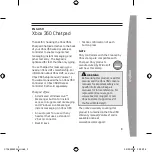
GEM80-400
2. Controller Architecture and Program Operation
Issue 3 04/99
ALSPA GEM80-400 SERIES CONTROLLERS TECHNICAL MANUAL
Page 2-5
2.2.1. Start-up Procedure, Initialisation
At switch-on, the controller initiates a self-test cycle. This cycle comprises a series
of self tests which are performed to check the following:
(1)
Memory;
(2)
Operating system EPROMs;
(3)
User program.
On completion, the I/O is cleared and then the user program is compiled. If a
fault is detected, the controller remains in the 'Halt' condition and the Error
handling routine is invoked, see the 'Fault Shutdown Procedure, Error Handling'
section of this chapter. Faults are reported as a code number and a text
message. These error numbers can be seen on the alphanumeric display on the
front panel of the processor.
After a successful self-test, the controller compiles the user program and, in doing
so, carries out a number of checks. If compilation is successful, the Watchdog
relay energises. See Chapter 11 of this manual for more detailed information. If
no errors are detected the Operating phase is cycled at least 3 times with the
Watchdog contacts open. If no errors are generated by these Operating cycles
the Watchdog contacts are closed and the controller then begins its normal
Operating phase.
2.2.2. Operating Cycle, Operation Phase
This is a continuous cycle and is the normal condition of the controller. During this
cycle the processor will set the output data. While this is happening the processor
is executing the user program. The processor reads input data from the input
modules, which the processor then uses in the program, i.e. the output data is
computed by the user Program. The serial data in the J/K-data tables is updated
at the beginning of each cycle.
At the end of each program cycle part of the continuous system self-tests are
performed and if any errors are generated the error handler is invoked which can
initiate a controller shutdown in the event of a fault.
2.2.3. Fault Shutdown Procedure, Error Handling
A segment of the self-test program is performed at the end of each program scan
and any detected fault results in the Error Handler being invoked which sends an
error message to the Printer/Programming port and an error code to the
processor display, inserting an entry into the System Log. The error handler then
tests the error status flags to determine the category of the failure. Depending on
the nature of the fault, action is then taken to ensure that the controller goes to a
safe condition. The controller can be restarted by switching the power off and
then on again, after the fault has been cleared.
There are three categories of error and these are detailed in Table 2.1.
Содержание GEM80-400 Series
Страница 1: ...GEM80 400 Series Controllers Technical Manual ABCD...
Страница 2: ......
Страница 3: ...ALSPA GEM80 400 Series Controllers Technical Manual Publication No T1614 Issue 3...
Страница 91: ...Page 2 24 ALSPA GEM80 400 SERIES CONTROLLERS TECHNICAL MANUAL Issue 3 04 99 This page left intentionally blank...
Страница 161: ...Page 3 30 ALSPA GEM80 400 SERIES CONTROLLER TECHNICAL MANUAL Issue 3 04 99 Figure 3 13 Typical Module Interlock Circuit...
Страница 170: ...Issue 3 04 99 ALSPA GEM80 400 SERIES CONTROLLER TECHNICAL MANUAL Page 3 39 This page left intentionally blank...
Страница 215: ...Page 5 12 ALSPA GEM80 400 SERIES CONTROLLERS TECHNICAL MANUAL Issue 3 04 99 Figure 5 4 STARNET Module...
Страница 217: ...Page 5 14 ALSPA GEM80 400 SERIES CONTROLLERS TECHNICAL MANUAL Issue 3 04 99 Figure 5 5 GEMLAN D Module...
Страница 252: ...Page 7 16 ALSPA GEM80 400 SERIES CONTROLLERS TECHNICAL MANUAL Issue 3 04 99 This page left intentionally blank...
Страница 273: ...Page 9 6 ALSPA GEM80 400 SERIES CONTROLLERS TECHNICAL MANUAL Issue 3 04 99...
Страница 316: ...Issue 3 04 99 ALSPA GEM80 400 SERIES TECHNICAL MANUAL Page A 5 2 1 1 Cover 2 Base plate Figure A 4 Clamped Cable...
















































